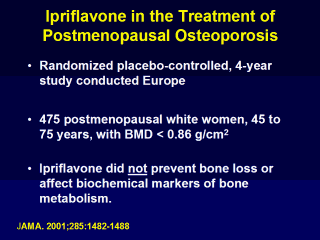 |
Did you see the Part I
and the Part II of this lecture? A Randomized Controlled Trial
Peter Alexandersen, MD; Anne Toussaint,
MD; Claus Christiansen, MD, PhD; Jean-Pierre Devogelaer, MD, PhD; Christian Roux, MD, PhD;
Jacques Fechtenbaum, MD, PhD; Carlo Gennari, MD, PhD; Jean Yves Reginster, MD, PhD; for
the Ipriflavone Multicenter European Fracture Study
Context: Data on the efficacy and
safety of ipriflavone for prevention of postmenopausal bone loss are conflicting.
Objectives: To investigate the effect of
oral ipriflavone on prevention of postmenopausal bone loss and to assess the safety
profile of long-term treatment with ipriflavone in postmenopausal osteoporotic women.
Design and Setting: Prospective,
randomized, double-blind, placebo-controlled, 4-year study conducted in 4 centers in
Belgium, Denmark, and Italy from August 1994 to July 1998.
Participants: Four hundred seventy-four
postmenopausal white women, aged 45 to 75 years, with bone mineral densities (BMDs) of
less than 0.86 g/cm2.
Interventions: Patients were randomly
assigned to receive ipriflavone, 200 mg 3 times per day (n = 234), or placebo (n = 240);
all received 500 mg/d of calcium.
Main Outcome Measures: Efficacy measures
included spine, hip, and forearm BMD and biochemical markers of bone resorption (urinary
hydroxyproline corrected for creatinine and urinary CrossLaps [Osteometer Biotech, Herlev,
Denmark] corrected for creatinine), assessed every 6 months. Laboratory safety measures
and adverse events were recorded every 3 months.
Results: Based on intent-to-treat
analysis, after 36 months of treatment, the annual percentage change from baseline in BMD
of the lumbar spine for ipriflavone vs placebo (0.1% [95% confidence interval {CI}, -7.9%
to 8.1%] vs 0.8% [95% CI, -9.1% to 10.7%]; P = .14), or in any of the other sites
measured, did not differ significantly between groups. The response in biochemical markers
was also similar between groups (eg, for hydroxyproline corrected for creatinine, 20.13
mg/g [95% CI, 18.85-21.41 mg/g] vs 20.67 mg/g [95% CI, 19.41-21.92 mg/g]; P = .96);
urinary CrossLaps corrected for creatinine, 268 mg/mol (95% CI, 249-288 mg/mol) vs 268
mg/mol (95% CI, 254-282 mg/mol); P = .81. The number of women with new vertebral
fracture was identical or nearly so in the 2 groups at all time points. Lymphocyte
concentrations decreased significantly (500/ÁL (0.5 109/L]) in women treated
with ipriflavone. Thirty-one women (13.2%) in the ipriflavone group developed subclinical
lymphocytopenia, of whom 29 developed it during ipriflavone treatment. Of these, 15 (52%)
of 29 had recovered spontaneously by 1 year and 22 (81%) of 29 by 2 years.
Conclusions: Our data indicate that
ipriflavone does not prevent bone loss or affect biochemical markers of bone metabolism. Additionally,
ipriflavone induces lymphocytopenia in a significant number of women. |
